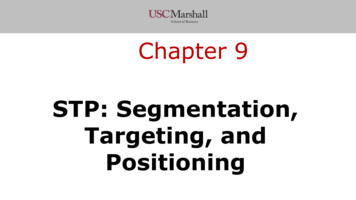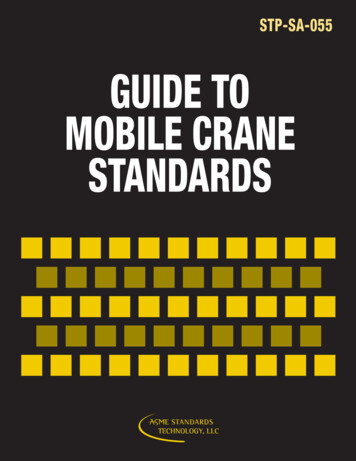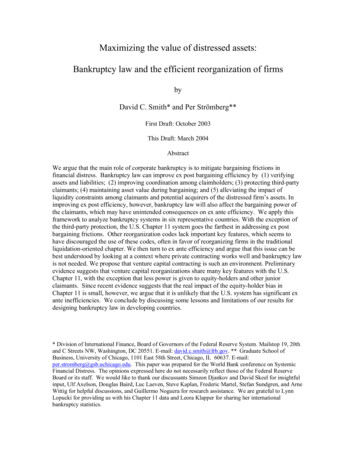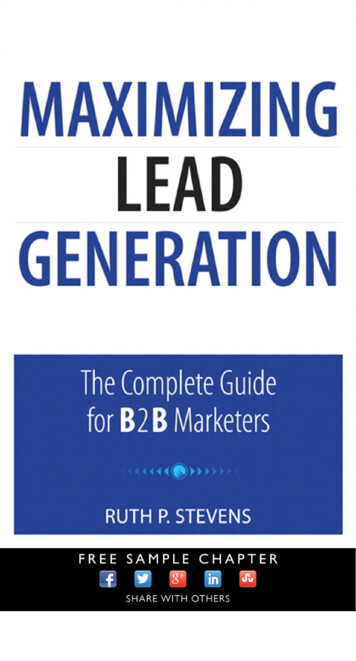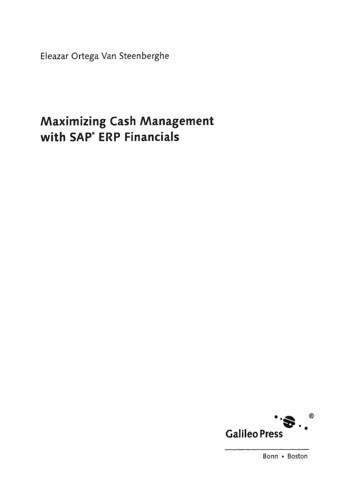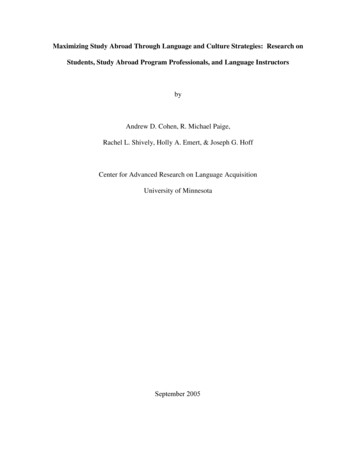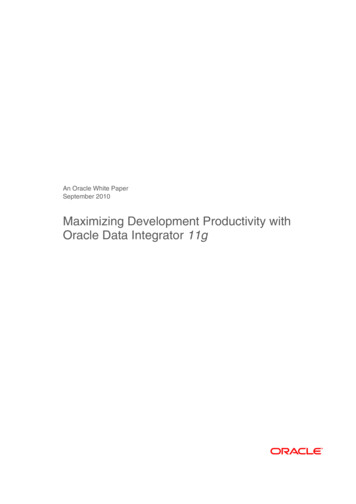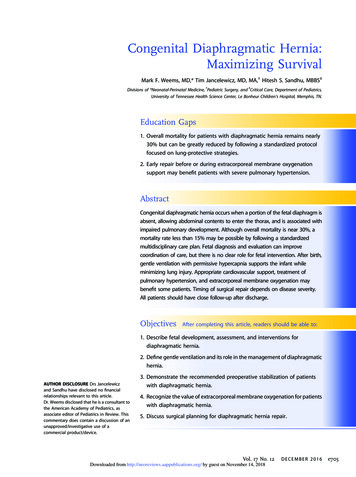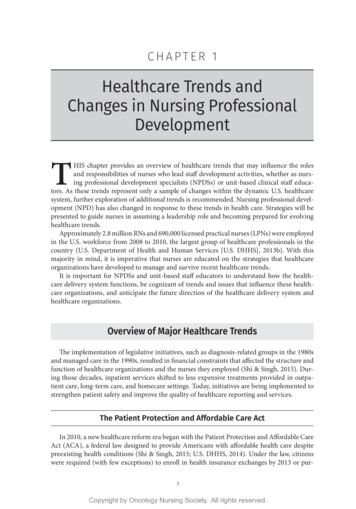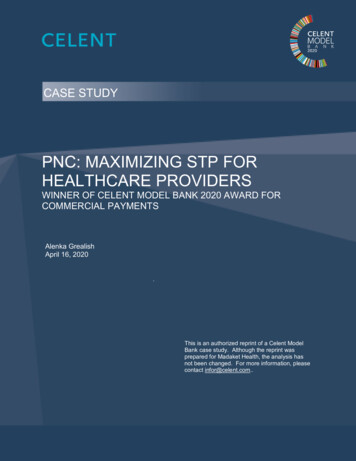
Transcription
CASE STUDYPNC: MAXIMIZING STP FORHEALTHCARE PROVIDERSWINNER OF CELENT MODEL BANK 2020 AWARD FORCOMMERCIAL PAYMENTSAlenka GrealishApril 16, 2020This is an authorized reprint of a Celent ModelBank case study. Although the reprint wasprepared for Madaket Health, the analysis hasnot been changed. For more information, pleasecontact infor@celent.com.Chapter: Select Visual Insights.1
CASE STUDY AT A GLANCEFINANCIAL INSTITUTIONPNC Bank, National AssociationINITIATIVEHealthcare Payer Enrollment AutomationSYNOPSISPNC recognized a pain point in healthcare providers’ revenue cycle: theneed for a more efficient payer enrollment process for EFT and eremittance. PNC Healthcare Payer Enrollment Automation removesextra steps from this process, while also maximizing efficiency andsubstantially reducing errors.TIMELINES Start: June 2018 Goal met to convert all healthcare provider clients to automated payerenrollment by January 2019 Client self-service user interface (UI) launched Q2 2019KEY BENEFITS Extensive quantitative results, ranging from cost and time savings toimproved accuracy, including:o Enrollment turnaround from an average of 32 days to 4.5 dayso Rejection rate down from 20% to 5%KEY VENDORMadaket, a SaaS and API provider that connects healthcare providersand payersCELENT PERSPECTIVE PNC understands patient billing, third-party payers (insurance companies), claimsprocessing and payments, and has decades of experience with the systems andapplications used to accomplish these processes. Payer enrollment historically has been an onerous, protracted process, which involves manyredundant processes, including data entry. Through a strong collaborative approach and API-skilled vendor, PNC was able to build anintuitive UI that allows both internal and external users to be fully functional on day one, withno lengthy user manuals or required training. The success of Healthcare Payer Enrollment Automation is evidenced by quantitativeresults, ranging from cost and time savings to improved accuracy — including a reduction inenrollment turnaround time from an average of 32 days to 4.5 days and in the rejection ratefrom 20% to 5%.Celent Case StudyPNC has a 25 year legacy of innovation in healthcare banking. Healthcare Payer EnrollmentAutomation is a prime example of how PNC can identify a pain point in healthcare providers’revenue cycle and help solve it.2
DETAILED DESCRIPTIONPNC is a leading treasury services provider in the US with 44,000 Corporate & InstitutionalBanking clients. Its Treasury Management business ranks in the top 4 (Ernst & Young, 2019),and it has earned client satisfaction awards.Table 1: PNC SnapshotPNC BANKYEAR FOUNDED1845REVENUE 17.8 billion (2019)ASSETS 410 billion (2019)GEOGRAPHICAL PRESENCEUSEMPLOYEESApproximately 52,000OTHER KEY METRICSApproximately 2,300 branchesRELEVANT TECHNOLOGIES ANDVENDORSMadaketSource: PNCIn developing Healthcare Payer Enrollment Automation, PNC is leveraging its experienceworking with thousands of payers and providers and running a healthcare clearinghouse.OpportunityAccording to the 2017 Council for Affordable Quality Healthcare Index, “even with [the] adoptionof electronic claim submission at 95%, 37% of claim payments” were made manually. Thiscreated an opportunity to lower costs by more than 9.4 billion by transitioning to electronictransactions. The bank that can unlock these cost savings stands to fortify its position inhealthcare banking. PNC is helping do just that with its Healthcare Payer EnrollmentAutomation. Given that PNC’s core healthcare provider clients are large healthcare systemswith over 5 million claims a year, PNC’s Healthcare Payer Enrollment Automation solution’svalue proposition is enormous.Celent Case StudyThe health insurance market in the US is highly fragmented with approximately 4,000 payers.To get paid by payers electronically and receive an e-remittance (aka 835), healthcare providersface the onerous task of navigating through myriad enrollment processes, which includediffering requirements (e.g., for signatures) and forms across payers. As a result, the enrollmentcycle time can take up to eight weeks, with payers rejecting an average of 20% of all enrollmentsubmissions (Figure 1). Rising fraud in healthcare e-payments has compounded the complexity.While healthcare providers are striving to digitize their revenue cycle — including straightthrough cash posting — this upstream step is sufficiently time-consuming, making theenrollment process less efficient.3
Figure 1: The Byzantine Traditional Enrollment ProcessPre-automation: Average cycle time at 32 days for EFTs and 20 days for 835enrollments Approximate cost per enrollment is 360 (this was PNC’s internalcost per enrollment) No enrollment level reporting internally or for clients Process complexity – 38 process steps and 15 decision pointsHealthcare Payer Enrollment Automation can help: Centralize enrollment data and requests Reduce average enrollment to 3 to 5 business days Eliminate redundant steps and re-work Show dashboard tracking and reporting statuses Align client self-service with digital onboarding Reduce error rateSource: PNCSolutionPNC’s goal with Healthcare Payer Enrollment Automation is to help maximize healthcareproviders’ efficiency in enrolling payers for e-payment and e-remittance and thereby drive uptheir straight-through processing (STP) rates. In particular, it helps large provider entities withthousands of National Provider Identifiers (NPIs) and numerous unique signers. Byautomatically populating payer and provider data into the enrollment forms, this can reduceenrollment cycle time by sending error-free enrollment data directly to payers.To develop its solution, PNC chose to work with a tech vendor, Madaket, based on itshealthcare-specific SaaS and API capabilities. Madaket created new and evolved existing APIsto meet PNC’s unique requirements given the existing level of service PNC delivers to clients,such as white glove service, superior technology, and extensive controls. With the support ofMadaket, PNC linked the payer enrollment requirements with its provider data and created anautomated workflow that addressed the needs of both payers and healthcare providers (e.g.,meeting signer requirements). The workflow helps: Centralize enrollment data and requests. Eliminate redundant steps and re-work.Celent Case StudyShifting from a manual paper-based process to a single source of data and automation requiredan overhaul of PNC’s internal payer enrollment and healthcare provider client onboardingprocesses. The new process allows it to show step-by-step who approved an enrollment.Prefilled PDFs and e-signatures add transparency and traceability that were lacking withmanual enrollments. Moreover, PNC can help mitigate fraud using an automated workflow thatlogs each step of the enrollment and the associated user, replacing PNC’s manual risk controlswith systemic controls.4
Provide dashboard tracking and reporting statuses (Figure 2). Offer client self-service aligned with digital onboarding. Reduce the error rate to less than 1%. Provide systemic fraud controls.To help provide a single digital experience to its healthcare provider clients, PNC leveragedMadaket APIs to integrate PINACLE (PNC’s corporate online and mobile banking portal) andHealthcare Payer Enrollment Automation into PNC Healthcare Advantage (its healthcareplatform). This integrated PINACLE platform enables clients to access PNC HealthcareAdvantage portal through a single sign-on and centralized entitlements. Healthcare providerclients can easily navigate between their traditional banking services and healthcare services —without having to log on to multiple systems.PNC used Angular (an open-source web development application) to build an intuitive userexperience that eliminated the need for lengthy training and user manuals. A critical part of thesolution development was user testing. PNC internal developers leveraged APIs to create areal-time interactive user experience. They used InVision click-through prototypes to givehealthcare provider clients and internal end-users a way to easily touch and see how thedevelopers translated their user journey into a functioning, user-friendly interface. Gatheringfeedback early and often yielded positive results: There was virtually no need for post-releaseenhancements or bug fixes.The intuitive UI is demonstrated by the screenshots below for healthcare provider clients. Figure2 shows two screens: the healthcare provider client dashboard with key metrics displayed at thetop and “tasks” to be done listed below, and the “Task Manager” page. A healthcare providerclient can click on the task and go to a screen that displays the task (e.g., provide digitalsignature) and the remaining steps to complete. This self-service feature was added after theinitial launch and evaluation of workflow improvements. Healthcare provider clients can viewenrollment status, complete enrollment review, e-sign, and upload required forms.Celent Case StudyFigure 2: Provider Dashboard and Task Manager5
Source: PNCApproachTo produce a well-designed, intuitive solution, PNC recognized that cross-team collaborationwas important during design and journey mapping. In addition, PNC recognized that client inputwas valuable. PNC wanted to increase overall project participation and generate a sense of“skin in the game.” PNC also recognized that it would have to reengineer a complicated processand hence chose to have its crews focused on both technology and process (unlike in traditionalapproaches, which have a tech team and a process team). As a result, PNC began byexamining best practices in electronic enrollment and then reengineered its process.Cross-team collaboration. The project involved process changes and a number of keystakeholders and experienced team members, as well as end users — client healthcareproviders, all of which contributed to its complexity. The core team consisted of 10 leadcontributors (including two project managers) from PNC and two from Madaket, each focusedon a specific work stream such as communications or internal training. Given that processengineering requires discipline and care, PNC assigned a manager for this stage who iscertified in change management.During the project, PNC held biweekly project meetings and remained focused on each workstream and deliverable, no matter how small. Weekly status reports captured the projecttimeline, task lists, risk, and upcoming activities. This level of detail and transparency kept theteam focused and on task.The internal development crews worked closely with Madaket to align shared backlogs andoverall prioritization. Through strong communication and daily stand-up meetings, they stayedaligned and worked in tandem.Celent Case StudyProviding visibility and consistent communication to the cross-team collaborators and acomprehensive project plan contributed to its overall success. Prior to kick-off, the project teammet with internal stakeholders from Onboarding, Payer Services, Payer Enrollment,Technology, and Product teams to provide an overview of the project plan and ask for dedicatedresources and support. As a result, teams were able to prepare for and be aware of anycomplexities.6
Project milestones included data conversion, defining internal process and support proceduresand training coordination, planning and distributing client communications, UPIC (UniversalPayment Identification Code) implementation, API mapping, and user interface integration(Table 2).Table 2: MilestonesDATACONVERSION161 daysDEFININGCRITICALELEMENTS105 and122 days,respectivelyCLIENTCOMMUNICATIONS118 daysUPICIMPLEMENTATION142 daysAPI MAPPING &USER INTERFACEINTEGRATION118 daysGO LIVEDESCRIPTION Establish PNC Clearinghouse setups within the Madaket system Payer Setups Pilot Phase 1 Provider SetupsInternal process Internal Operational Processes Procedure for data integrity Define Client Support ModelTraining internal users and Implementation Support (Payer Enrollment, Onboarding,Implementations) Develop training content for provider setup Develop training content for payer setup Create test payers/providers in lower regionClient Management: Planning and distributing communications Identify Pilot Clients Introductory demos for Pilot Clients Universal Payment Identification Code (UPIC) communication (develop anddistribute to clients)For fraud protection, UPIC is used for all EFT enrollments1 Pilot Clients setup Setups for waves 1, 2, 3 Update bank letters Development of screensAPI/UI mappingHistorical data loadEstablish screen APIsIntegrate UI/APISolve exceptionsEstablish report interfaceBulk upload interface Pre-Deployment: 14 daysDeploy in test environment complete validationDay one turnoverDaily monitoring (PNC/Madaket)Pilot client go live with screen share so PNC can watch and answer any questionsPilot feedback collected weekly by Product ManagementFeedback from pilot clients provided to agile crews for mockup design1. PNC’s goal is to help with this additional layer of protection so that its healthcare provider clients’ account informationis shielded during the enrollment process. Because there is no way to verify how a payer or third party stores, restrictsaccess to, or protects banking information provided during enrollments, using UPICs block debits, adding a layer ofprotection against a bad actor attempting to redirect funds. The combination of UPICs with an automated traceableworkflow and locked forms can help provide systemic controls for its clients.Source: PNCCelent Case StudyMILESTONE7
Client input is paramount. Starting the pilot with a select number of clients and payer setupsprovided the opportunity to identify and address potential gaps. Madaket and the internaldevelopment crews worked together to respond to feedback regarding how to help simplify theuser experience. In addition, development crews anticipated new user needs and built featuresnot originally in the core product such as bulk upload of an entire client setup, which, for a largehealth system, could include hundreds of locations and NPIs.ResultsPNC’s healthcare provider clients migrated to the new process in January 2019. As shown inFigure 3, PNC achieved positive operational and business results. Clients say they “love thenew system” and find it “fast and easy to use.” Thanks to automation and an intuitive design,clients are reporting drastically reduced time spent on enrollment. One client reported that workthat used to take an employee five hours a week to complete has been reduced to one hour. Inaddition, as a result of the project’s successes, PNC product delivery teams have created amodel that is used consistently to support all cross-team collaboration and development.Additional results include a decline in the amount of support tickets. Because the automatedenrollment process and technology let clients view their enrollment status, the number ofsupport tickets submitted by clients for missing data with a root cause tied to an enrollmentissue has started to decline. For example, for PNC’s largest pilot client, overall support ticketsrelated to enrollment dropped from 15% of total support tickets to 4.4% in just four months.Source: PNCCelent Case StudyFigure 3: Results – Pre and Post8
Copyright NoticePrepared byCelent, a division of Oliver Wyman, Inc.Copyright 2020 Celent, a division of Oliver Wyman, Inc., which is a wholly ownedsubsidiary of Marsh & McLennan Companies [NYSE: MMC]. All rights reserved. Thisreport may not be reproduced, copied or redistributed, in whole or in part, in any form orby any means, without the written permission of Celent, a division of Oliver Wyman(“Celent”) and Celent accepts no liability whatsoever for the actions of third parties in thisrespect. Celent and any third party content providers whose content is included in thisreport are the sole copyright owners of the content in this report. Any third party content inthis report has been included by Celent with the permission of the relevant content owner.Any use of this report by any third party is strictly prohibited without a license expresslygranted by Celent. Any use of third party content included in this report is strictlyprohibited without the express permission of the relevant content owner This report is notintended for general circulation, nor is it to be used, reproduced, copied, quoted ordistributed by third parties for any purpose other than those that may be set forth hereinwithout the prior written permission of Celent. Neither all nor any part of the contents ofthis report, or any opinions expressed herein, shall be disseminated to the public throughadvertising media, public relations, news media, sales media, mail, direct transmittal, orany other public means of communications, without the prior written consent of Celent.Any violation of Celent’s rights in this report will be enforced to the fullest extent of thelaw, including the pursuit of monetary damages and injunctive relief in the event of anybreach of the foregoing restrictions.This report is not a substitute for tailored professional advice on how a specific financialinstitution should execute its strategy. This report is not investment advice and should notbe relied on for such advice or as a substitute for consultation with professionalaccountants, tax, legal or financial advisers. Celent has made every effort to use reliable,up-to-date and comprehensive information and analysis, but all information is providedwithout warranty of any kind, express or implied. Information furnished by others, uponwhich all or portions of this report are based, is believed to be reliable but has not beenverified, and no warranty is given as to the accuracy of such information. Publicinformation and industry and statistical data, are from sources we deem to be reliable;however, we make no representation as to the accuracy or completeness of suchinformation and have accepted the information without further verification.Celent disclaims any responsibility to update the information or conclusions in this report.Celent accepts no liability for any loss arising from any action taken or refrained from as aresult of information contained in this report or any reports or sources of informationreferred to herein, or for any consequential, special or similar damages even if advised ofthe possibility of such damages.There are no third party beneficiaries with respect to this report, and we accept no liabilityto any third party. The opinions expressed herein are valid only for the purpose statedherein and as of the date of this report.No responsibility is taken for changes in market conditions or laws or regulations and noobligation is assumed to revise this report to reflect changes, events or conditions, whichoccur subsequent to the date hereof.PNC and PINACLE are registered marks of The PNC Financial Services Group, Inc. (“PNC”). Banking andlending products and services, bank deposit products, and treasury management services, including, but notlimited to, services for healthcare providers and payers, are provided by PNC Bank, National Association, awholly-owned subsidiary of PNC and Member FDIC. 2020 The PNC Financial Services Group, Inc. All rightsreserved.
For more information please contact info@celent.com or:Alenka ranceJapan99 High Street, 32nd FloorBoston, MA 02110-23201 Rue EulerParis75008The Imperial Hotel Tower, 13th Floor1-1-1 Uchisaiwai-choChiyoda-ku, Tokyo 100-0011Tel.: 33.1.45.02.30.00Fax: 33.1.45.02.30.01Tel: 81.3.3500.3023Fax: 81.3.3500.3059USAUnited KingdomHong Kong1166 Avenue of the AmericasNew York, NY 1003655 Baker StreetLondon W1U 8EWTel.: 1.212.541.8100Fax: 1.212.541.8957Tel.: 44.20.7333.8333Fax: 44.20.7333.8334Unit 04, 9th FloorCentral Plaza19 Harbour Road, WanchaiUSAItalyFour Embarcadero Center, Su
PNC is a leading treasury services provider in the US with 44,000 Corporate & Institutional Banking clients. Its Treasury Management business ranks in the top 4 (Ernst & Yo
